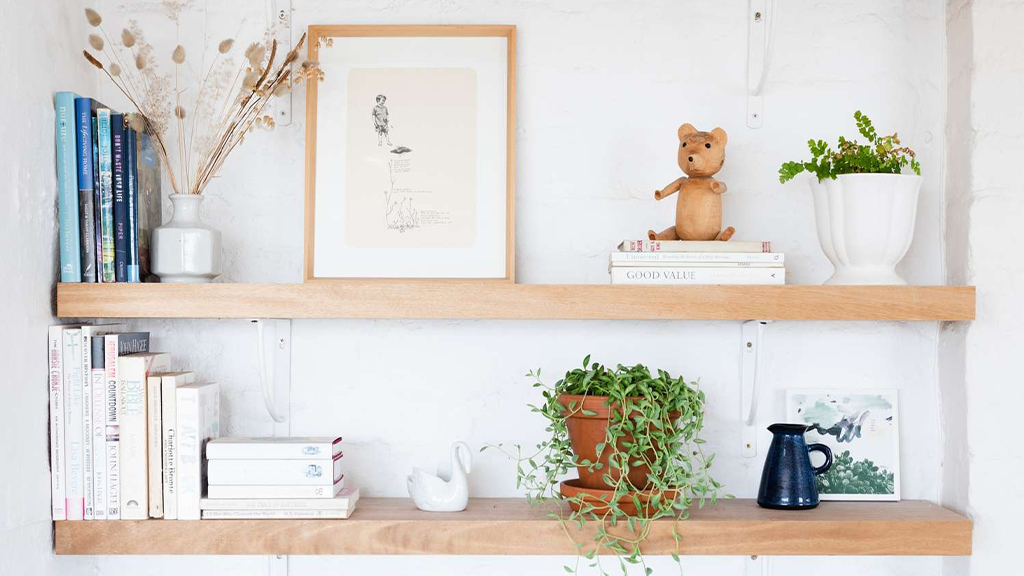Shelves are a great way to show off your personal style and add character to any room in your home. Regardless of whether you have built-in or freestanding bookshelves, there are several ways to design a shelf so that it looks beautiful and organized. In this article, we share some tips and ideas to help you design your shelves and create a stunning display.
Start with a blank slate
The first step in designing a shelf is to start with a blank panel. Take everything off the shelf and dust it thoroughly. This will help you see the room clearly and give you a fresh start for work.

Choose a color scheme
Before you start adding items to the shelf, choose a color scheme. This will help you create a cohesive look and tie everything together. You can go for a neutral palette of whites, grays and browns, or you can opt for bold and bright colors that stand out.
Mix and match textures
Combine textures to add visual interest. Combine smooth and rough textures, glossy and matte, and soft and hard textures. This adds depth and dimension to your display and makes it more visually appealing.
Play with scale and proportions
When designing a shelf, it’s important to play with scale and proportions. Mix up small and large items to create balance and keep things interesting. For example, you can combine a small vase with a large book, or a tall candlestick with a small figurine.
Use books as a basis
Books are a great way to anchor your display and add height to the shelf. Stack books horizontally and vertically to create a base for other items. You can also use books as a backdrop for smaller items like a vase or figurine.
Add green
Plants and flowers are a great way to add life and freshness to your display. Choose plants that suit your space and style, such as succulents, ferns, or flowers. You can place them in pots or vases and group them together for a cohesive look.
Use decorative items
Decorative items such as figurines, vases and sculptures are a great way to add personality and style to your display. Select items that match your interests and style and mix and match to create a unique presentation.
Don't forget the negative space
Negative space is just as important as the items on your shelf. Leave some space between items to create balance and give rest to the eye. This will make your display look clean and tidy.

Use different materials
Mixing different materials can add excitement and structure to your shelf. For example, you can combine wood, glass, metal and ceramic objects to create a varied and visually appealing presentation. Consider using materials that complement each other, such as a wooden vase with a metal figurine.
Create a focus
Creating a focal point can draw attention and add interest to your exhibit. You can do this by placing a large or conspicuous item in the center of your shelf, such as a sculpture or painting. You can also use a group of smaller objects, such as a collection of vases or candles, as a focal point.
Play with symmetry
Symmetry can give your display a sense of order and balance. You can achieve symmetry by placing identical items on each side of the shelf, or by placing larger items in the middle and smaller items on the sides. This creates a visually appealing display that is easy on the eye.
Use a pop of color
A pop of color is a great way to add interest and draw attention to your display. You can achieve this by incorporating a bold and bright color like red or yellow into your display. For example, you can add a splash of color to your shelf with a bright red vase or a yellow decorative item.
Consider scale and depth
When designing a shelf, scale and depth are important. You can add depth by placing items in front of or behind each other, such as a vase in front of a stack of books. You can also play with scaling by mixing small and large items, as mentioned earlier.

Don't forget the negative space
Negative space is important for creating a visually appealing presentation. Leaving some free space on your shelf can add balance and prevent your display from looking cluttered. Don’t be afraid to leave some breathing room between items.
Use plants
Adding plants to your display can add life and freshness to your shelves. Consider using a mix of small and large plants like succulents or ferns to add texture and greenery to your display. You can also place plants in decorative pots or planters to add color and style.
Create a story
Creating a story with your display can add depth and interest to your shelves. For example, you can create a beach decoration with sea shells, a parasol and a framed picture of the ocean. Or you can create a presentation inspired by your favorite book or film by incorporating items that represent the story.
Use a theme
Using a theme can help create a cohesive and visually appealing ad. For example, you can create an ad inspired by a specific color, such as blue or green, by incorporating elements in that color scheme. Or you can create a presentation inspired by a specific season, such as fall or winter, by incorporating seasonal items.
Play with textures
Playing with textures can add interest and depth to your ad. Consider using items with different textures, such as a fluffy cushion or woven basket to add visual interest and variety to your display.
Integrate personal items
Incorporating personal items into your display can add a sense of warmth and personality to your shelves. Consider including items with sentimental value, such as family photos, travel memorabilia, or heirlooms, to create an exhibit that is unique to you.
Mix and match styles
Mixing and matching styles can add a unique and eclectic touch to your display. Consider combining modern and vintage items or mix different styles like rustic and industrial to create a presentation that is both interesting and coherent.
In summary, designing a shelf is a great way to express your personal style and add interest to your interior design. With these additional tips and ideas, you can take your shelving design to the next level and create a beautiful and unique display that reflects your personal taste and interests. So have fun, be creative and experiment with different styles and techniques to create a presentation that is unique to you.

